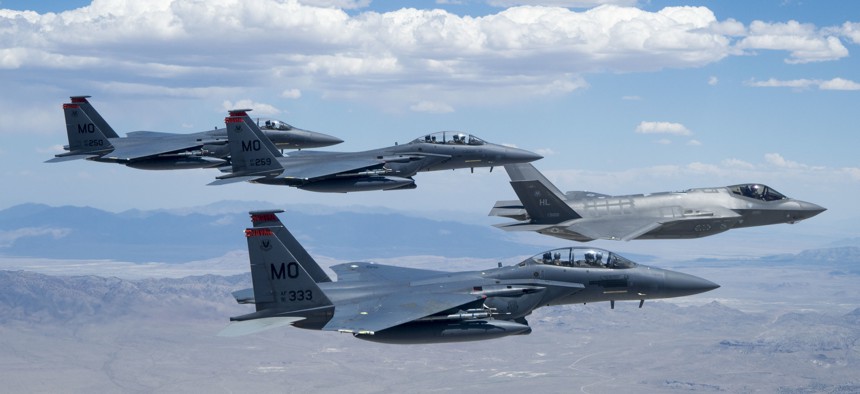
Then-Lt. Gen. Mark Kelly leads a formation of F-35 Lightning ll and F-15E Strike Eagles over the Utah Test and Training Range in July 2018. Airman 1st Class Codie Trimble
Air Force General Defends Plans for Mixed F-35, F-15 Fleet
Top Air Force generals are expected to discuss the service’s future fighter force in upcoming meetings.
The U.S. Air Force needs to buy two kinds of new fighter jets to be ready for a complex war against China or Russia, a top general said Monday.
Gen. Mark Kelly, head of Air Combat Command, defended his service’s decision to add the Boeing F-15EX, a new version of a half-century-old design, to a fighter-jet shopping list that until recently had consisted solely of Lockheed Martin’s F-35.
Kelly, who has flown both aircraft, says the new version of the F-15 is “a game-changing aircraft” with an easily upgradable digital mission system and the ability to carry heavy weapons.
“We have to present a peer adversary with multiple challenges to fend off both inside threat rings and outside threat rings with lower radar-cross-section threats and big payloads and a mix of problems,” the general said at the Air Force Association’s Virtual Air, Space & Cyber conference. “This aircraft will have the brains to assess and decide quickly, speed and fuel to cover a big area and some pretty significant hitting power.”
F-35 advocates argue that its lower price tag and stealth make it a more versatile option than the F-15EX, a new version of the F-15 that can strike both targets in the air and on the ground. The F-15C, which the F-15EX will replace, can only shoot down planes and cannot hit ground targets.
Kelly said he expects top U.S. Air Force generals to debate the makeup of the fighter jet force at Corona meetings in coming weeks.
“I have no doubt that part of those discussions will be that balance of capacity numbers and capability high end,” he said. “Those are two of the most recurring discussions that we have.”
For years, Air Force leaders resisted buying non-stealthy, or fifth-general jets. But that changed last year when the Air Force said it would buy new F-15s to replace a F-15C.
“They're going to look at the entire [combat air force] portfolio holistically,” Kelly said. “I just don't see us discussing an apples-versus-oranges in an F-35-versus-F-15EX scenario.”
The F-15s were supposed to be replaced by more than 700 F-22 Raptors, but former Defense Secretary Robert Gates capped production at 187 jets.
Since then Air Force leaders have brushed off questions about whether the service would stick to its plan to buy 1,763 F-35s, saying that discussion would not need to be made for years to come.
But development problems added years of delays, and although the F-35’s price tag is coming down and its reliability going up, Air Force leaders have been increasingly talking about buying new fleets of fighter jets that are cheaper to build and upgrade called the Digital Century Series.
Another consideration is industrial: buying both the F-15 and the F-35 keeps two U.S. fighter-jet makers in business.
This week at the Air Force Association’s Air Space Cyber virtual conference, Lockheed plans to announce a new initiative, called Stardrive, within its aeronautics business to compete for this new line of fighter jets.
“Think of model-based systems engineering, think about factory of the future, software development in terms of containerization technologies like Kubernetes, and agile [software] and then even into sustainment in terms of how we use data analytics and [artificial intelligence],” Michele Evans, the president of Lockheed Martin Aeronautics, said in an interview last week. “I think the technologies are just going to provide tremendous opportunities to speed up the development in the delivery of platforms going forward.”




